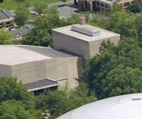Billingsville School
1927 establishments in North CarolinaMecklenburg County, North Carolina Registered Historic Place stubsNational Register of Historic Places in Mecklenburg County, North CarolinaRosenwald schools in North CarolinaSchool buildings completed in 1927 ... and 2 more
School buildings on the National Register of Historic Places in North CarolinaSchools in Charlotte, North Carolina

Billingsville School is a historic Rosenwald School building located in the Grier Heights community of Charlotte, Mecklenburg County, North Carolina. It was built in 1927 as a school for African-American students. It is a one-story, hip-roofed school building in the Bungalow and American Craftsman style with a brick veneer, symmetrical facade, and a steeply pitched, front gable porch. A small, flat-roofed, brick addition was built in 1949.It was added to the National Register of Historic Places in 1999.
Excerpt from the Wikipedia article Billingsville School (License: CC BY-SA 3.0, Authors, Images).Billingsville School
Skyland Avenue, Charlotte Grier Heights
Geographical coordinates (GPS) Address Phone number Website Nearby Places Show on map
Geographical coordinates (GPS)
| Latitude | Longitude |
|---|---|
| N 35.196111111111 ° | E -80.808333333333 ° |
Address
Billingsville Elementary School
Skyland Avenue 124
28205 Charlotte, Grier Heights
North Carolina, United States
Open on Google Maps




